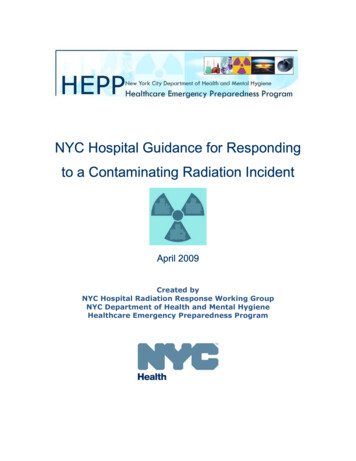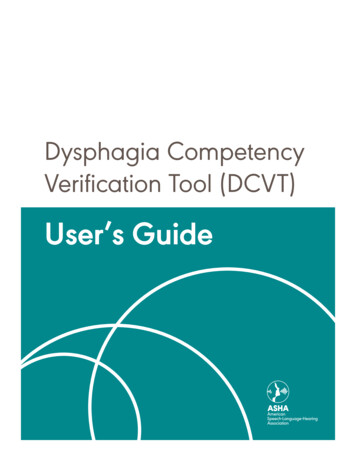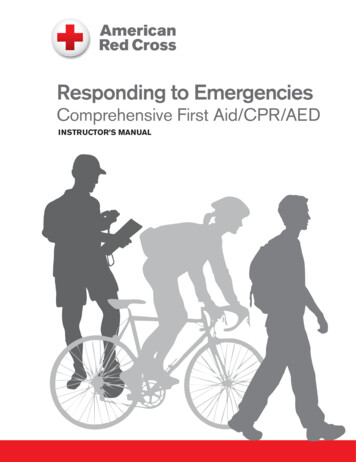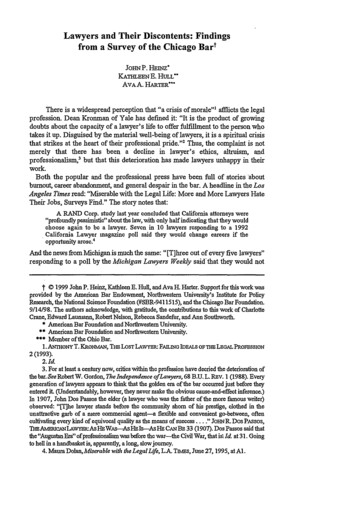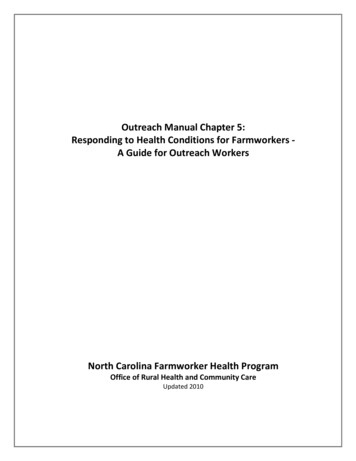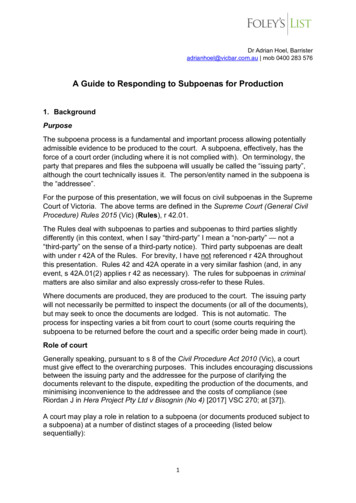
Transcription
Dr Adrian Hoel, Barristeradrianhoel@vicbar.com.au mob 0400 283 576A Guide to Responding to Subpoenas for Production1. BackgroundPurposeThe subpoena process is a fundamental and important process allowing potentiallyadmissible evidence to be produced to the court. A subpoena, effectively, has theforce of a court order (including where it is not complied with). On terminology, theparty that prepares and files the subpoena will usually be called the “issuing party”,although the court technically issues it. The person/entity named in the subpoena isthe “addressee”.For the purpose of this presentation, we will focus on civil subpoenas in the SupremeCourt of Victoria. The above terms are defined in the Supreme Court (General CivilProcedure) Rules 2015 (Vic) (Rules), r 42.01.The Rules deal with subpoenas to parties and subpoenas to third parties slightlydifferently (in this context, when I say “third-party” I mean a “non-party” — not a“third-party” on the sense of a third-party notice). Third party subpoenas are dealtwith under r 42A of the Rules. For brevity, I have not referenced r 42A throughoutthis presentation. Rules 42 and 42A operate in a very similar fashion (and, in anyevent, s 42A.01(2) applies r 42 as necessary). The rules for subpoenas in criminalmatters are also similar and also expressly cross-refer to these Rules.Where documents are produced, they are produced to the court. The issuing partywill not necessarily be permitted to inspect the documents (or all of the documents),but may seek to once the documents are lodged. This is not automatic. Theprocess for inspecting varies a bit from court to court (some courts requiring thesubpoena to be returned before the court and a specific order being made in court).Role of courtGenerally speaking, pursuant to s 8 of the Civil Procedure Act 2010 (Vic), a courtmust give effect to the overarching purposes. This includes encouraging discussionsbetween the issuing party and the addressee for the purpose of clarifying thedocuments relevant to the dispute, expediting the production of the documents, andminimising inconvenience to the addressee and the costs of compliance (seeRiordan J in Hera Project Pty Ltd v Bisognin (No 4) [2017] VSC 270; at [37]).A court may play a role in relation to a subpoena (or documents produced subject toa subpoena) at a number of distinct stages of a proceeding (listed belowsequentially):1
At the point where the issuing party seeks to issue a subpoena, the court mayrefuse to issue a subpoena bad on its face. If an application to set aside a subpoena as objectionable in form oroppressive is made, the court may grant that application in whole or part. The addressee may advance some other “good reason” why documentsshould not be produced (including that the documents are original title deedsor production would infringe the right against self-incrimination). This is anamorphous set of circumstances which does not necessarily depend upon theaddressee attacking the basis of the subpoena itself. Assuming documents have been produced, upon the issuing party applying toinspect the documents, the court may qualify or even deny inspection. The court may refuse to permit a party to tender a document in evidence,despite it having been produced and inspection permitted. 1This presentation will basically concern the second and fourth stages.What is an objection?An “objection” refers to one of two principal things which are quite distinct.There is objecting to a subpoena (or part of it) as distinct from objecting to theinspection of specific documents produced pursuant to a subpoena. An objection to a subpoena is where the addressee (or occasionally otherpersons) alleges that some/all of a subpoena is bad at law and that it ought tobe set aside to that extent. Objecting to production is where your client is not alleging that the subpoena,itself, is bad at law, but that a particular document (or class) should not beinspected by the issuing party for a recognised reason (such as client legalprivilege). This is akin to an objection to production in the discovery process.Limited usePrivacy and confidentiality are not bases, in themselves, for objecting to a subpoena.Documents produced may only be used for the purposes of that proceeding. Theyare protected in the same fashion as discovered documents. 2See Roux v ABC [1992] 2 VR 577, at 595.See Harman v Secretary of State for the Home Department [1983] 1 AC 280 and Hearne v Street(2008) 235 CLR 125.122
2. What do you do initially when your client is served with a subpoena?Always properly read the rule named in the subpoena and the subpoena itself.The Rules vary slightly from court to court and also when naming third-parties. Sonecourts have useful informational documents in respect of complying with subpoenas.The forms of subpoenas and third-party subpoenas are also slightly different.An “addressee” is required to comply with a validly issued subpoena to the extent ofthe terms of the subpoena itself and the relevant Rules of court. No more and noless. Non-compliance is very serious and can amount to contempt of court. Is your client properly named? Was your client properly served? 3Subpoenas must be served in accordance with the relevant service andexecution of process legislation (and objections must also have regard to thatlegislation). Was the subpoena served within time by reference to the terms of thesubpoena/Rules?Who is the addressee?The Rules are slightly different in respect of third-parties, including that they have anabsolute right to the costs of compliance, including seeking legal advice if necessary.Reasonable costs will ordinarily be ordered to be paid by the issuing party. A thirdparty must seek an order from the court to this end.If you are a party, you may need to consider how the subpoena interacts with othercompulsory processes like discovery. The subpoena may be issued because theissuing party had not sought discovery and the issuing party is trying to play a bit of“catch-up-tennis” – this not an express basis for objection in itself (but such anapproach will likely allow objections for oppression etc – see below).Separately, the addressee may also realise that it ought to have already discovered(and perhaps produced) the documents falling within the subpoena already.3. What does the subpoena say about compliance and the documentsthemselves?Time for complianceIs the time listed in the subpoena consistent with the relevant legislative provisionpursuant to which the subpoena is issued? If they are different there may be a rangeof reasons, including a “data entry” error. It may also be because the wrong formhas been used (hence reading the form and provisions properly).3 Informal service may suffice so long as your client has “actual knowledge” of it within the date forservice — see r 42.06(3) and 42.12(2) of the Rules.3
Produce documents and give evidence?Be careful to check whether the subpoena seeks evidence (oral evidence) as well asthe productions of documents. If it is, “conduct money” must be provided areasonable time before compliance is required — in the absence of this, theaddressee need not comply with the subpoena at least as far as giving evidence(see r 42.06(1) of the Rules).In at least few cases I have been involved in, the issuing party’s practitioners haveinadvertently sought both when they actually only intended to seek documents (thismay be a relief to your client). If this has occurred, this should be confirmed inwriting to avoid any confusion later.Copies versus originalsDoes the subpoena seek “originals” or “copies”? Under r 42.06(6) of the Rules,copies can be produced unless the subpoena expressly requires originals.This is important for two principal reasons: If your client does not produce originals (and originals are sought in thesubpoena), then the client will have failed to comply with the subpoena (andthe practitioner may be directly liable for costs and/or liable in tort to theclient).If the subpoena seeks originals, then you need to ensure that the relevantcourt registry (or Prothonotary) is made aware of this when you produce thedocuments, because some may have the documents destroyed without priornotice to you. Some administrative documents of court in relation tosubpoenas actually specifically ask the lodging party to actually declare this(the court will return all documents if you declare at least one is an original).4. Steps after being served Who do the documents belong to?Does the addressee simply possess the documents (but there belong or werecreated by some third party)? Either way, absent a proper objection, the documentsmust be produced.If the documents were created (or are owned) by some other person (or if they havesome interest in their contents), it may be prudent to advise that person (though thiswill not change the addressee’s obligations to the court). That other person maywish to make objections, and/or may be willing to defray the costs of makingobjections.Initial contacts/correspondenceIf there is any doubt that your client will be able to comply with the subpoena in atimely fashion, it is preferable to raise this as early as possible with the issuing party.4
Things to consider referring to in initial contacts/correspondence with or to theissuing party, include: You could seek copies of pleadings and/or any orders in the proceedingreferring to or dealing with subpoena. The former may assist you tounderstand whether there is a technical basis for objecting to the subpoena.It may also assist you to understand what documents are sought (and assistyou to consider offering to provide a narrower range of documents).Regarding relevant orders, sometimes, there may be court orders requiringsubpoenas to be filed by a certain date (and/or subject to leave) — if there isand the instant subpoena was filed out of time (and without leave), thesubpoena should not have been issued (see r 42.02(2) of the Rules). Foreshadow any likely issues of compliance, including timings for compliance.You may even wish to seek that the date for compliance be adjourned (orforeshadow that this may be necessary) (this is permitted under rr 42.03.1and 42.06(4)(b) of the Rules). Foreshadow objections, including oppression (this could note that the classesof documents are broad/unconstrained and/or note the approximate numberof hours/pages that they would cover). The benefit of doing this at this time isthat the other side may quickly amend or constrain the documents referred towhich may obviate the need for your client to provide more settled particularsfor a similar result. Any particulars regarding compliance (including estimatesof time) referred to at this stage should be qualified — this is so they do notprejudice particulars given later. Similarly, an addressee may foreshadow anobjection that there is no “legitimate forensic purpose” (LFP) for seeking thedocuments and request the issuing party to state the LFP. You may wish to carbon copy the other party/parties and even non-parties inon any correspondence (those people may object to subpoena without theneed for you to do so and/or underwrite your objection).5. What must be done by the date set out in the subpoena (assuming the dateis consistent with the empowering legislation etc)Absent situations where it is literally impossible to comply with any aspect of asubpoena, it is incumbent upon a party to comply to the extent possible, with thesubpoena. This is even if an application to have the subpoena set aside in whole (orpart) is foreshadowed.An example of a situation where it would be literally impossible would be where thataddressee has no idea, based on the subpoena (and any pleadings etc), whatdocuments fall within it. This might arise because the description of the documentsset out in the subpoena, themselves, do not make sense. Theoretically, but lessclearly, it may include situations where such a broad class of documents aredescribed that it is not really possible for the addressee to know what to produce andwhat not to produce.5
If some classes (or even just parts of those classes) of documents named in thesubpoena are capable of being produced (or if some documents within a single butobjectionable class), those documents should be produced in compliance with thesubpoena. Producing something is better than nothing even if your client is seekingto have some or all of the subpoena set aside. It is quite common for parties toagree to provide some classes of document but raise objections in relation to otherclasses.If some/all of the documents are subject to claims (or if your client has not been ableto assess them), you should produce the relevant documents to the registry (orProthonotary) noting on the relevant administrative documents submitted that theyare or may be subject to claims. It is prudent to actually physically place thedocuments that are (or may be) subject to claims in sealed envelopes or bags,clearly marked to say that the documents are or may be subject to objection. Thereare administrative documents of the court which can also be filled out to this endPursuant to r 42.07(3), if more than one document is produced, the Prothonotarymay request the addressee to produce a list of documents.6. Objecting to subpoena itselfBackgroundThe vast majority of disputes regarding subpoenas are resolved without the need foran objection to be actually heard by a court.Having said that, parties of often put to the trouble of raising objections incorrespondence and/or filing applications to object to a subpoena before reaching anagreed position.Where an actual hearing is conducted: The parties to the application will make submissions on the law (what the LFPis etc). There may also need to be submissions made on the nature of anyoppression. There may need to be evidence, including affidavit evidence, filed regardingoppression (eg regarding the number of likely documents and person hoursto find and assess them etc). The court may inspect the documents prior to making any ruling (particularlyif there is argued to be no LFP). 44The principles governing such application were set out by Derham As J in Webb v Wheatley [2015]VSC 153, at [55].6
Correspondence setting out the basis for any objection should be sent prior toany formal application being filed.For costs purposes and in order to try to resolve an objection without undue cost,objections should be properly raised (and characterised) in correspondence beforeany formal application is filed. Under the cover of any such correspondence, it mayalso be open to a party to propose a different or narrow range of document that theparty is willing and able to produce (eg limited by time, hard or digital copydocuments/type of document).Where this is done, the proposing party should do this on the basis the issuing partywill “not press” the relevant item number (or class of document described) in thesubpoena. If the issuing party agrees to this, that issue will no longer be in dispute.Others may still subsist, of course. The parties may exchange a number of lettershammering out a mutually-acceptable class of documents.If the addressee has not been able to review the relevant documents at the time ofthe offer is made (including for privilege), it is prudent to note this in thecorrespondence and say words to the effect that:Our client has not yet been able to assess these documents, including forprivilege. Subject to this letter and your client’s agreement, our client willproduce these documents pursuant to the subpoena, but reserves the right toraise objections should they properly arise.Who can seek to have a subpoena set aside?Rule 42.04 of Rules provides (r 42A.07 is of similar effect in relation to third-partysubpoenas):42.04 Setting aside or other relief(1)The Court may, of its own motion or on the application of a party or ofany person having a sufficient interest, set aside a subpoena in wholeor in part, or grant other relief in respect of it.(2)An application under paragraph (1) shall be made on notice to theissuing party.(3)The Court may order that the applicant give notice of the application toany other party or to any other person having a sufficient interest.A superior court of record also has the inherent jurisdiction to intervene to prevent anabuse of process.Sometimes, a person (who is not the addressee) may object to a subpoena,including on the basis of the imprecise language of a subpoena or the absence ofLFP. There can be good reasons to do so. See, example, Slaveski v AttorneyGeneral (Vic) [2013] VSCA 165, in which subpoenas were issued to various judgesand officers in circumstances where the issuing party alleged a wide-rangingconspiracy against him. The Attorney-General objected. In that case (and the7
decision below), the subpoenas were found to be vague, to seek irrelevantdocuments, to be oppressive and to be an abuse of process.While there may be an circumstances where you client may wish to allow others toobject in your client’s place, your client may be the most appropriate person to putobjections (eg oppression based on impermissibly broad terms will normally meritaffidavit evidence regarding how long it would take the addressee to search for andassess documents). Separately, if the addressee does not object to a subpoena,this may (but may not always) undermine the objection of a third party.If you are producing documents created or the property of others, it is advisable toinform those persons of the subpoena in writing and well prior to producing them.They may then opt to make an objection and that will be a matter for them.Usual basesSome of the following bases have a degree of overlap. They are also often arguedalongside each other.Abuse of process:This is argued according to the ordinary definition of what amounts to an abuse ofprocess, including where a subpoena is being used for a purpose ancillary to theproceeding itself.LFP:An issuing party must: Identify expressly and precisely the legitimate forensic purpose for whichaccess to the documents is sought — this is irrespective of whether othergrounds of objection can be made out. Essentially, identify how the documents would assist its case.This is not a particularly demanding test but demands more than simple relevance,at minimum, requiring the issuing party to establish it is “on the cards” or there is a“reasonable possibility” that it will assist its case. It is permissible to subpoenadocuments regarding credit alone (but the credit of the relevant person would alsohave to be in issue).A so-called “fishing expedition” (ie seeking documents to see if they are relevantand/or if there is an LFP) or a subpoena for some “abstract purpose” is notpermitted.In correspondence to the issuing party: You may request that the issuing party identify the LFP. You may even state that the documents could not affect any issues in disputebased on your reading of the court documents (this would generally require8
some familiarity with the case and it may also, in the case of a client who isparty, unintentionally reveal weaknesses in the issuing party’ case which itcould then attempt to fix). Remind the issuing party that a subpoena cannot be used as a proxy fordiscovery.Any such correspondence (and any response/non-response) can be produced insupport of an objection).Oppressive:For oppression even to arise, the issuing party must satisfy the court that there is alegitimate forensic purpose.Oppression can be based on the subpoena being expressed imprecisely, unclearlyor impermissibly broadly. Examples of this include (these are slightly edited realexamples): “Documents, including [then a narrow category or set of categories]”Note — this technically requires the addressee to produce any and alldocuments possessed by it. “Documents in relation to the Commissioner’s understanding of the purposeof the Policy.”Note — this requires the addressee to form a view regarding what the term“in relation to” means (does this mean “about”, “expressly referring to”,“evidencing”?) and, separately, what “understanding of the purpose” means.A subpoena must identify the documents falling within it with a proper degreeof particularity.Even if the subpoena identifies the subject documents relatively clearly, oppressionmay also be argued where a subpoena has unduly onerous timelines (having regardto the documents subpoenaed) or would require an unreasonable degree of effortand/or voluminous documents to be assessed (and/or actually produced). This mayinclude circumstances where: The addressee is required to make fine judgments about the relevance ofdocuments and/or calling upon the addressee to intimately know the issues indispute. This is particularly relevant where the addressee is a third-party. Irrespective of whether the documents are expressed with a proper degree ofparticularity, the addressee is required to undertake a search of anexcessively large volume of documents.Note — if the issuing party is prepared to meet the costs of this and thetimings allow for proper searches, this may undermine such an objection (butthe issuing party may have difficult establishing an LFP).9
In correspondence to the issuing party, you may set out particulars of the abovematters: The approximate full-time equivalent hours that it would take to:o Conduct searches for and/or assess all of your client’s documents,including hard copy and digital files. There could also be references tosearches conducted (with search terms identified and the number of“hits” listed).o Seek legal advice in respect of producing the documents.This is highly relevant for institutional/Government clients. Any relevant issues regarding access to the documents, including if they arearchived off-site. Any particularly resourcing constraints, including staffing and business flows(ie complying with the subpoena would put your client out of business, or inthe case of a Government client, preclude it from carrying out its statutoryresponsibilities). For completeness, particularly where the addressee is a party, it may berelevant to note what other documents have been produced as part of otherprocesses, including discovery or prosecutorial disclosure obligations.This can be produced in and/or supplemented by affidavit material filed in support ofan objection.Some specific scenarios where this comes upObjections are often made in the following circumstances: In criminal matters, where an accused seeks to impugn search warrants orwarrants for listening devices so attempt to subpoena the backgrounddocuments.In such situations, in the absence of clear and articulated basis to impugn awarrant (as opposed to a “mere assertion” of bad faith), courts will find there isan insufficient LFP and set the subpoena aside (public interest immunity mayalso be raised in tandem). 5 5In criminal matters generally, where the accused seeks documents outsidethe ordinary range of documents ordinarily produced as part of theprosecutorial disclosure obligations.See Commissioner of AFP v Magistrates’ Court of Victoria [2011] SC 3 (J Forrest J), [28]-[30].10
In civil matters involving the State as a party (or where its documents may berelevant even if it is not a party) simply because a poorly-worded subpoenacan pick up so many documents. Cases in which conspiracies are allegedare often ones in which subpoena objections are made, particularly where theissuing party is not legally represented.Costs?Where a subpoena objection is successful, an addressee, particularly a third-party,will ordinarily be awarded its costs. They can even be fixed on the day (this will savethe need for taxation etc). While a third-party will normally be awarded the costs ofcompliance, it may not be awarded the costs of an unsuccessful objection.If you do this, you may need to check if there are any relevant scale fees and/orhave bills at court setting out the costs, including of that day and any relevantdisbursements (including Counsel’s fees). See r 42.11 of the Rules.In appropriate cases, costs can be ordered against an issuing party’s solicitors.7. Objection to inspectionAt the time of producing documents pursuant to a subpoena, the addressee (or aparty/person with a sufficient interest) may advise the court that it objects to theinspection of one or more documents (see r 42.09 of the Rules and r 42A.08 inrelation to third-party subpoena). The addressee must, in writing, set out the basisfor the objections. Parties and third parties can also raise objections at this point.Where this occurs, r 42.09(7) of the Rules precludes a court from permittinginspection and the objection must be referred for hearing and determination (and theissuing party notified so it can also appear and be heard).Categories of objection include things like: Client legal privilege. Public interest immunity. 6 Medical privilege.These will be argued according to their ordinary legal principles and limitations. Thistype of application could be heard at the same hearing as an objection to asubpoena but, ordinarily, there would need to be rulings made on the subpoenaobjections first.Costs orders can be made in respect of these objections, too. The costs position willbe better for a person who properly sets out the basis for the claim beforehand so asto give the issuing party a meaningful opportunity to not press the subpoena to theOn public interest immunity, see a separate Foley’s List CPD presentation delivered by me:Understanding Public Interest Immunity In The Age Of Lawyer X (2020)(see https://foleys.com.au/ResourceDetails.aspx?rid 397&cid 58).611
extent of the objection. The costs position may also vary having regard to the natureand strength of the objection and the reasonableness of the issuing party in pressingthe subpoena.8. Tips and issuesIs it easier to just give the other side the documents?The addressee is still required to comply with the subpoena unless the other sideformally withdraws it.Either way (and even if the subpoena is withdrawn or the issuing party agrees to doso), practitioners must be very careful here. Subpoenas are an intrusive poweroverseen by the courts. Improperly circumventing or misapplying the protections onthat power is very serious. While it is not necessarily professionally wrong to request(or give) documents in parallel to a subpoena, any such arrangement must becognisant of the following matters: Any production in parallel can only ever be asked for (and given) on avoluntary basis (ie not under threat). Practitioners should be at pains toensure that this is clear. Such production should be made only where the documents are not oneswhich might reasonably be the subject of objections by others persons (eg forclient legal privilege/public interest immunity) (so as not to render the ordinaryobjection process nugatory). Requests made for this (and the giving pursuant to such a request) shouldalways be expressed to be made (or given) on the basis that the documentswill be treated as if they had been produced pursuant to the subpoena (eglimited use etc) (it would be prudent that the issuing party and the addresseeexchange correspondence confirming this before any documents are actuallyprovided).In a similar way, it is problematic to allow (even a well-meaning) issuing party toassist with the lodging of documents produced pursuant to a subpoena.Conduct of this nature may amount to a contempt of court and/or professionalmisconduct/unsatisfactory conduct.Do I need to turn up in court if my client’s document are lodged in time?This is generally only an issue in respect of third-party subpoenas.If the documents are lodged within the timings set out in the subpoena (or any laterdate agreed by the issuing party), attendance is not usually necessary.If there is any doubt (and assuming nothing is in dispute in relation to the subpoena),it may be prudent to (in writing) ask the issuing party whether they requireattendance and/or simply advising the other party that you do not propose to attend(or that, if you are forced to attend, you will seek your client’s costs).12
If you wish to seek your client’s reasonable costs, including legal costs, you shouldattend court (in some courts, you may, yourself, need to apply to have the subpoena“returned”). Have a look at any informational documents in the relevant jurisdiction— they will assist with this.Can I use the documents for a different proceeding if the addressee agrees?Assuming the documents have not been tendered (other otherwise made publiclyavailable), no. The Harman obligation is owed to the court. The agreement of the addresseeis not sufficient to discharge and subsisting obligation. To use the documents, an application would have to be made to the court inwhich the subpoena was issued and an order made to permitting this. It mayalso be possible for a fresh subpoena to be filed in the new proceedings.9. Further readingLexisNexis, Civil Procedure Victoria, [I 42.01] onwards and [I 42A.01] onwards.13
and the instant subpoena was filed out of time (and without leave), the subpoena should not have been issued (see r 42.02(2) of the Rules). Foreshadow any likely issues of compliance, including timings for compliance. You may even wish to seek that the date for compliance be adjourned (or
